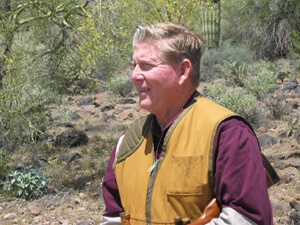 Photo Credit JT's Guide Service Photo Credit JT's Guide Service
ONE WITH NATURE
Jerry Tate, JT's Guide Service, shares his experiences of becoming one with nature, close to the wildlife, and sensitive to all that is growing. Calling upon the lessons from native people and from the ancestors, one can survive in and be part of the desert.
Previously, in articles one and two, we had mentioned harvesting big game. Preparation can start from the melt off of the last snow, up to one week prior to your hunt.
I know some are asking why start preparing so early in the season. The more you know the animals habits, the easier it is to key in on their locations at various times of the year.
By reading the signs, the story slowly unfolds. Your senses awaken; you are aware of your surroundings and of the aura of the setting around you.
Now, see it in the air, look at the trees, and see the life force that feeds the forest. It is in the air, trees, ground, sky, light, and shadows; feel all interruptions to the flow of this sense.
As the glow of life, your sensitivity is heightened at that point. You really cannot see it with your eye, but instead, with your mind s eye. You know it in your knower, but there is no word that can describe it.
To confirm your senses, you have to investigate, but you must be true to those senses. When you are doing this, no other human being can be in your space; someone can be near you, just not in your space.
Now that your senses are heightened, and you are in the right area, you are ready to locate the animals.
The animals should be at the intermediate snow levels or lower where the snow has not prevented them from feeding. You can confirm this by looking for the vegetation that has been eaten from existing plants and thus know they have browsed on.
As I walk, I can see where the pine tree needles have been nipped at, and the places where the bark has been eaten from the trees during the winter months. Notice where grasses and weeds have been eaten and where the vegetation has not been touched because there is not the right nutrition for that animal, at that time.
Keep in mind at all times they need four things: food, water, shelter and space.
Think: Where would their bedding locations be, how far is the water, food, and shelter from these places? Where are the main trails leading in and out of these locations? They use these trails as we use freeways, roads and streets.
Spring-through-fall habitats coincide with each other. Usually this is in the upper elevation where it is cool; they are feeding on the new shoots that are coming up from the snowmelt and early spring rains.
With all the new vegetation coming up, they have the nutrients available from nature to have good, healthy offspring. There is nothing more rewarding to an outdoorsman than watching animal behavior within these herds where new life is nurtured. This is how you learn about the species.
For those of you who just want to be in tune with the symphony of nature, and simply watch the intermingling of the adults, yearling, and juvenile over a period of eight hours or so: You will be impressed with, rewarded from, and at awe of the harmony of it all.
Some people never get to experience this in their entire lives.
As you can see, we have just mentioned how the symphony of nature comes together: the wildlife, and the ecosystem. To greater enhance your senses, a walk with Jerry and the symphony of nature, at night, is the next footprint.
Dinghy Digest ®
|